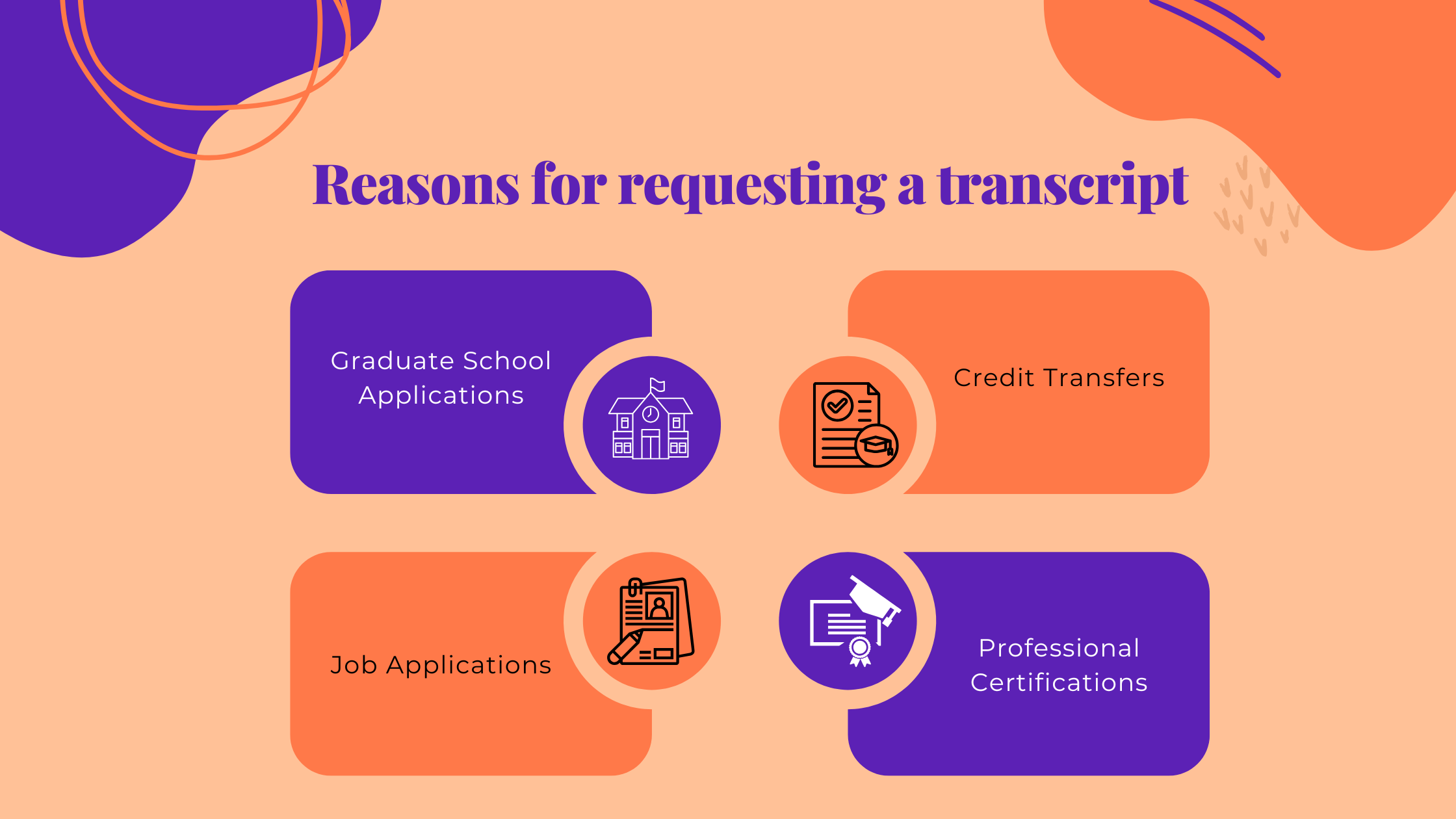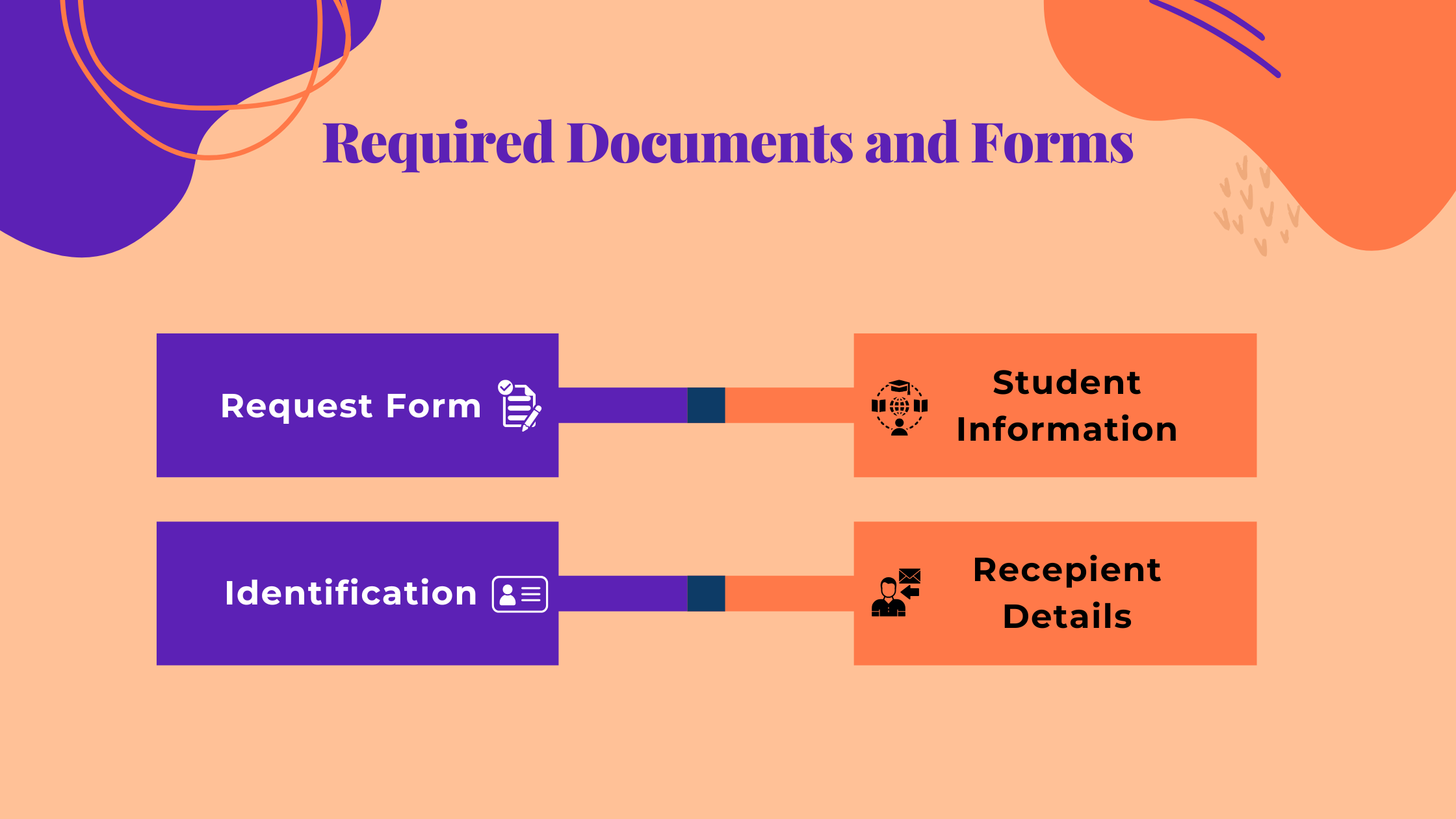So, you’ve been asked to submit a transcript, or maybe you need one to apply for a new program. Whether you’re looking to transfer credits, apply to graduate school, or meet a job requirement, transcripts are a key part of your academic record.
In this guide, we’ll walk you through every step of the process so you can easily request and receive your transcript certificate.
Understanding Transcripts
What is a Transcript?
In short, your transcript is a detailed record of your academic journey, capturing every course you’ve completed, the grades earned, and often additional key details like your overall GPA, academic honors, and, in some cases, extracurricular involvement.
This document not only reflects your academic progress but also serves as a verification of your educational credentials. Transcripts offer a window into your intellectual commitment and skills, illustrating for future schools or employers the breadth of your knowledge, your academic strengths, and your consistency over time.
This record can be critical in a variety of situations, from college applications and scholarship opportunities to job interviews and professional certifications, helping decision-makers understand your academic history at a glance.
Official vs. Unofficial Transcripts
You’ll hear these terms a lot, so it’s worth knowing the difference.
-
Official transcripts are certified documents sent directly by your school to the requested institution or individual. These are usually sealed to ensure authenticity.
-
Unofficial transcripts, on the other hand, are typically digital or printed copies that you can access yourself, often through your student portal. They’re great for personal use or initial review but won’t be accepted for formal applications.
How Does a Grade Sheet Differ from a Transcript?
A grade sheet provides a focused look at your academic performance over a specific period, typically summarizing your grades for a single semester or a specific set of courses. Grade sheets are often used to show immediate performance, helping students and institutions alike monitor short-term academic standing and track improvements or challenges over the course of their studies.
On the other hand, a transcript is a complete archive of your academic history, encompassing every semester, every course, and every grade you’ve earned over the entire duration of your studies. Transcripts are far more extensive, reflecting not only your grades but also additional credentials like your GPA, degree completion, honors, and sometimes even activities or certifications tied to your academic career.
This level of detail makes the transcript a critical document for applications and formal verifications, giving potential schools or employers a well-rounded picture of your academic life and dedication.

Why You Might Need Your Transcript
Reasons for Requesting a Transcript
Transcripts are essential in various scenarios where formal proof of education is required, acting as an official record of your academic accomplishments and helping institutions and employers validate your qualifications. Here’s where transcripts commonly come into play:
-
Graduate School Applications: For graduate programs, admissions committees rely on transcripts to assess the depth and rigor of your undergraduate coursework. They look at your grades, course selection, and GPA to gauge your readiness for advanced study and determine if your academic background aligns with the program’s requirements.
-
Job Applications: Many employers request transcripts as part of the hiring process, particularly for entry-level positions or roles requiring specialized skills. By reviewing your academic performance, they can confirm your qualifications, gauge your subject expertise, and gain insights into your work ethic, consistency, and areas of strength. Transcripts can be especially important in fields like finance, engineering, education, and healthcare.
-
Credit Transfers: When transferring from one institution to another, a transcript is crucial for credit evaluations. It allows the new school to see which courses you’ve completed and decide if they align with its own curriculum standards. This process helps you avoid retaking similar courses, saving time and money as you transition to a new program.
-
Professional Certifications: Certain professional certifications, like those in law, teaching, healthcare, or accounting, require proof of specific courses or degrees. A transcript provides verifiable documentation of the relevant academic achievements, ensuring that you meet the prerequisites for certification. It validates that you possess the foundational knowledge required for certification exams and further professional training.
Do You Need an Official or Unofficial Transcript?
When it comes to formal applications, official transcripts are typically non-negotiable because they serve as a verified, tamper-proof record of your academic performance. An official transcript is usually sent directly from your institution to the recipient, often in a sealed envelope or through secure digital channels.
This added security ensures the transcript hasn’t been altered, which is essential for applications where accuracy and integrity are crucial—such as when applying for graduate school, certain jobs, or professional certifications.
Official transcripts provide an institution’s assurance that the document reflects your genuine academic history, granting confidence to recipients who depend on that accuracy for decision-making.
On the other hand, unofficial transcripts are more flexible and can be useful for personal review or informal sharing. They’re typically accessible through student portals and can often be downloaded or printed without additional costs.
Unofficial transcripts provide the same detailed overview of your academic record but lack the formal seals or signatures of an official version. If you’re simply checking your grades, planning future coursework, or sharing your academic progress with family or friends, an unofficial transcript can meet your needs.
Where to Get Your Transcript
Institutions and Sources for Transcripts
Most institutions provide several ways to request your transcripts, making it easier to access your academic records. You can request them directly from the high school or college where you completed your education or through the university’s registrar office, which typically handles transcript requests.
Additionally, online platforms like EduTranscript, Parchment, the National Student Clearinghouse or your school’s student portal have simplified the process, allowing you to request and send transcripts digitally.
EduTranscript by CertifyMe is quickly becoming the popular choice for transcript workflow management, thanks to its global reach, user-friendly features, and exceptional support, while Parchment and the National Student Clearinghouse primarily serve users in the US and Canada.
How to Obtain Transcripts if the School is Closed
If your school has closed, don’t worry! Many closed institutions transfer their records to the state’s department of education or other designated archives. You can contact the state education office where your school was located, or search online archives that specialize in closed schools’ records.
How to Request Your Transcript
Step-by-Step Guide for Requesting Transcripts
Ready to make the request? Here’s a simple guide to requesting your transcript, whichever method you choose:
-
Online Portals: If your school uses an online service, log in to the portal, select your institution, and follow the instructions to request your transcript. Payment may be required, so have a credit or debit card ready.
If you’re using EduTranscript by CertifyMe, all you need to do is log in using your credentials, choose the type of transcript you need, upload the necessary information (like ID or forms), and make a secure payment online. You can even track the status of your order directly from your dashboard, from university approval to the moment your transcript arrives at your doorstep.
-
Registrar’s Office: This is the traditional route. If you’re on campus or near your school, stop by the registrar’s office. Otherwise, you can call or email them to initiate the process. You will find their contact on the “Contact” page of the university website.
-
Mail Requests: For institutions that don’t offer digital options, you might need to submit a written request by mail. This process may take a bit longer, so plan ahead.
What Happens if You’ve Been Out of School for a Long Time?
If you graduated a while ago, you might wonder if your records are still accessible.
Schools maintain records for many years, but it’s a good idea to check with your institution. Older records may take longer to retrieve, especially if they’re stored in archived systems.

Documents and Information Required for a Transcript Request
Required Documents and Forms
When requesting a transcript, be prepared with:
- Identification (often a student ID or government-issued ID).
- Request form or online form completion.
- Student information such as your student ID number, graduation year, and program details.
- Recipient details, including where or to whom the transcript will be sent.
Fees and Processing Information
Transcript requests often come with a fee, which can range from $5 to $25 per document. Payment options vary depending on your institution; many accept credit or debit cards, while others may require checks or money orders for mailed requests. Some institutions work also work with high risk merchant accounts to make sure the payment process goes smoothly.
Processing Times and Delivery Options
How Long Does it Take to Receive Your Transcript?
Processing times vary widely. Some institutions offer same-day digital delivery, while others may take a few days to a few weeks, especially if you’re requesting a hard copy. Be sure to check with your institution for an estimated timeline, especially if you’re working with a deadline.
Expedited Options for Quick Delivery
If you need your transcript quickly, many schools offer expedited services for an additional fee. This can include priority shipping or faster processing times for digital transcripts.
How to Send Official Transcripts to Universities
When applying to universities or jobs, you’ll often need to send your transcript directly from the institution. When requesting your transcript, specify the recipient’s contact information, including the email or physical address where it should be sent. Many institutions allow you to send transcripts directly through online portals.
To do this using EduTranscript, just log in to the platform, submit a request, and specify the institution you want to send your transcript to. Include the contact details of the recipient, whether it’s an admissions guide, administrative office, or university dean, along with the document’s submission deadline.
Once your request is submitted, the admin from your school or college takes over the process for you. You can then track every step with complete transparency on the platform, from when the transcript is sent to when it’s received by your target institution.
Potential Issues and Solutions
Can a College Withhold Your Transcript?
Unfortunately, yes, a college can withhold your transcript if you have unpaid tuition, library fees, or other outstanding balances. If you’re facing this issue, contact your school’s billing office to discuss payment options or negotiate a hold release. Some schools offer payment plans or alternative solutions, especially if you need the transcript for a critical purpose.
How to Differentiate Between Official and Unofficial Transcripts
If you receive your transcript and aren’t sure if it’s official, check for a few indicators: Seal or watermark: Official transcripts often feature a seal or watermark. Direct delivery: Official transcripts are sent directly from your school to the recipient. If it’s sent to you first, it may be unofficial. Digital security: Many digital transcripts come as secure PDFs that can’t be easily altered or copied.
Conclusion
In summary, obtaining a transcript certificate is a straightforward but essential process, whether you’re continuing your education, applying for a job, or transferring credits. We’ve covered all the basics, from understanding the types of transcripts and knowing when to choose official over unofficial, to locating records from closed institutions and resolving common issues like withheld transcripts. By following the steps outlined above, you can be well-prepared to secure and send your academic record whenever you need it.
Tools like EduTranscript by CertifyMe make ordering transcripts quick and hassle-free, offering easy online access and secure delivery to institutions. With features like expedited options and a reliable order history, CertifyMe keeps the process stress-free and incredibly efficient.
If you’re a high school or college student, or part of a university registrar or admin team, EduTranscript is definitely worth checking out—it’s super easy to use and makes the whole process a breeze. You can give it a try for free right and I promise you’ll find it super helpful!
.png)
 Author :
Author : 




